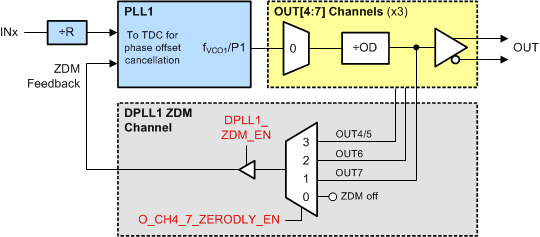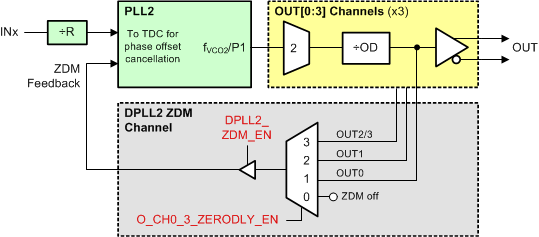SNAS724A February 2018 – April 2018 LMK05028
PRODUCTION DATA.
- 1 Features
- 2 Applications
- 3 Description
- 4 Revision History
- 5 Description (continued)
- 6 Pin Configuration and Functions
- 7 Specifications
- 8 Parameter Measurement Information
-
9 Detailed Description
- 9.1 Overview
- 9.2 Functional Block Diagrams
- 9.3
Feature Description
- 9.3.1 Oscillator Input (XO_P/N)
- 9.3.2 TCXO/OCXO Input (TCXO_IN)
- 9.3.3 Reference Inputs (INx_P/N)
- 9.3.4 Clock Input Interfacing and Termination
- 9.3.5 Reference Input Mux Selection
- 9.3.6 Hitless Switching
- 9.3.7 Gapped Clock Support on Reference Inputs
- 9.3.8 Input Clock and PLL Monitoring, Status, and Interrupts
- 9.3.9
PLL Channels
- 9.3.9.1 PLL Frequency Relationships
- 9.3.9.2 Analog PLL (APLL)
- 9.3.9.3 APLL XO Doubler
- 9.3.9.4 APLL Phase Frequency Detector (PFD) and Charge Pump
- 9.3.9.5 APLL Loop Filter
- 9.3.9.6 APLL Voltage Controlled Oscillator (VCO)
- 9.3.9.7 APLL VCO Post-Dividers (P1, P2)
- 9.3.9.8 APLL Fractional N Divider (N) With SDM
- 9.3.9.9 REF-DPLL Reference Divider (R)
- 9.3.9.10 TCXO/OCXO Input Doubler and M Divider
- 9.3.9.11 TCXO Mux
- 9.3.9.12 REF-DPLL and TCXO-DPLL Time-to-Digital Converter (TDC)
- 9.3.9.13 REF-DPLL and TCXO-DPLL Loop Filter
- 9.3.9.14 REF-DPLL and TCXO-DPLL Feedback Dividers
- 9.3.10 Output Clock Distribution
- 9.3.11 Output Channel Muxes
- 9.3.12 Output Dividers
- 9.3.13 Clock Outputs (OUTx_P/N)
- 9.3.14 Glitchless Output Clock Start-Up
- 9.3.15 Clock Output Interfacing and Termination
- 9.3.16 Output Synchronization (SYNC)
- 9.3.17 Zero-Delay Mode (ZDM) Configuration
- 9.3.18 PLL Cascading With Internal VCO Loopback
- 9.4 Device Functional Modes
- 9.5 Programming
- 9.6 Register Maps
- 10Application and Implementation
- 11Power Supply Recommendations
- 12Layout
- 13Device and Documentation Support
- 14Mechanical, Packaging, and Orderable Information
Package Options
Mechanical Data (Package|Pins)
- RGC|64
Thermal pad, mechanical data (Package|Pins)
Orderable Information
9.3.17 Zero-Delay Mode (ZDM) Configuration
Zero-delay mode can be enabled to achieve zero phase delay between the selected reference input clock and the output clocks of a DPLL. As shown in Figure 52 and Figure 53, DPLL1 supports zero-delay for OUT4/5, OUT6, and OUT7, while DPLL2 supports zero-delay for OUT0, OUT1, and OUT2/3. Any output that requires the zero-delay feature should be derived from the PLL's P1 (primary) post-divider and have zero-delay enabled (DPLLx_ZDM_EN bit = 1). Then, one of the outputs per DPLL can be selected as the primary zero-delay output (by O_CHx_y_ZERODLY_EN bit). Other outputs that need zero-delay can be synchronized with the primary zero-delay output by comprising a SYNC group (see Output Synchronization (SYNC)). ZDM and DCO mode should not be enabled at the same time within a PLL channel.
When the DPLL is acquiring lock to the reference input, the initial phase lock is governed by the DPLL fastlock bandwidth. Once phase lock is detected, the final output phase alignment with the input reference is governed by the normal DPLL loop bandwidth. The same phase lock and alignment process also occurs when exiting holdover or after a switchover event.
 Figure 52. DPLL1 ZDM Configuration for OUT4 to OUT7
Figure 52. DPLL1 ZDM Configuration for OUT4 to OUT7  Figure 53. DPLL2 ZDM Configuration for OUT0 to OUT3
Figure 53. DPLL2 ZDM Configuration for OUT0 to OUT3